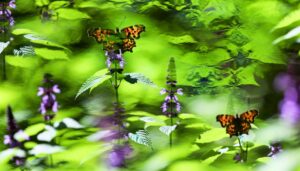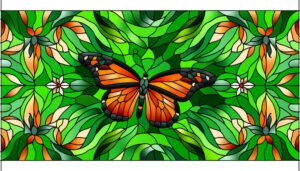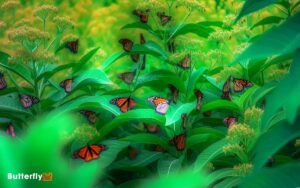Monarch Butterfly Vs Painted Lady – Key Differences
The Monarch Butterfly (Danaus plexippus) and the Painted Lady (Vanessa cardui) differ greatly in physical appearance, distribution, and behavioral patterns. Monarchs have orange wings with black veins, while Painted Ladies display a mosaic of orange, brown, and black.
Monarchs are native to North America and require milkweed for their larvae, undertaking long migrations to Mexico. In contrast, Painted Ladies are cosmopolitan, adaptable to diverse environments, and exhibit unpredictable migration based on food availability.
Both species play crucial roles in pollination but face threats such as habitat destruction and climate change. To uncover more intricate details about these fascinating butterflies, continue exploring.
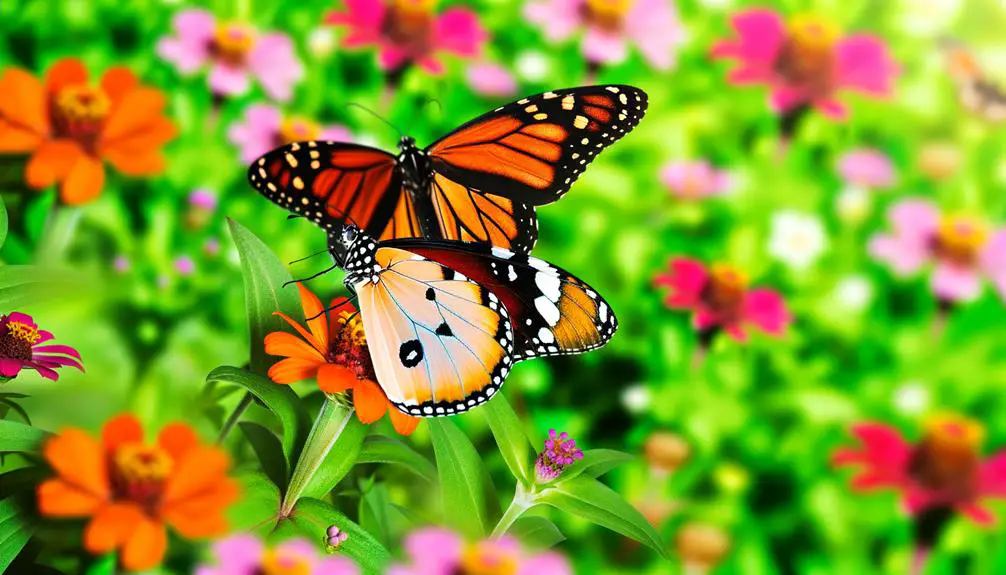
Key Takeaways
- Monarchs have a distinct orange and black wing pattern, while Painted Ladies feature a more complex mosaic of orange, brown, and black.
- Monarchs primarily inhabit North America, whereas Painted Ladies have a worldwide distribution.
- Monarch butterflies undertake long-distance migrations to Mexico, unlike the more erratic migrations of Painted Ladies.
- Monarch caterpillars exclusively eat milkweed, whereas Painted Lady caterpillars have a more varied diet, including thistles and mallows.
Physical Appearance
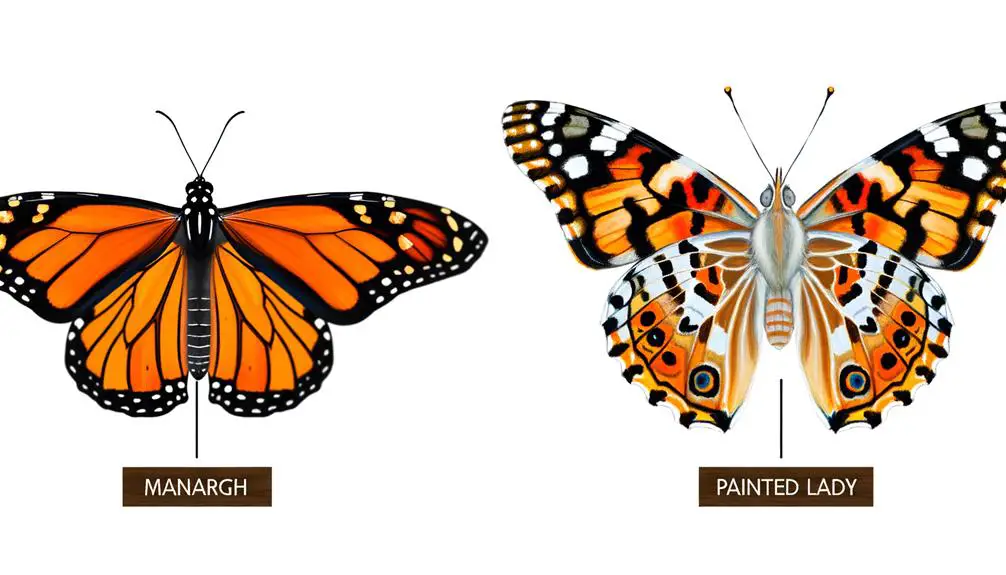
In terms of physical appearance, the Monarch butterfly (Danaus plexippus) and the Painted Lady (Vanessa cardui) exhibit distinct differences in their coloration, wing patterns, and size.
Monarch butterflies are characterized by their striking orange wings, marked with black veins and white spots along the margins. Typically, Monarchs have a wingspan of approximately 3.5 to 4 inches.
Conversely, Painted Ladies display a more complex coloration, featuring a mosaic of orange, brown, and black hues with white spots near the tips of their forewings. Their wingspan ranges from 2 to 2.9 inches.
The Monarch's vivid coloration serves as a warning to predators about its unpalatability, while the Painted Lady's more intricate colors can aid in camouflage.
Wing Patterns
The wing patterns of Monarch butterflies and Painted Ladies exhibit notable differences in color variations, unique marking features, and seasonal changes. Monarch butterflies display bold orange wings with black veins and white spots along the edges, while Painted Ladies have a more intricate pattern with a mix of orange, brown, and white hues. Additionally, seasonal changes can influence wing coloration, with some butterflies appearing darker or more vibrant depending on the time of year. Understanding these variations also helps distinguish between similar species, such as recognizing monarch vs viceroy differences based on wing patterns and subtle structural traits.
Monarchs are characterized by their vibrant orange wings with black veins and white spots along the edges, while Painted Ladies display a more complex mosaic of orange, brown, and black with distinctive eye spots.
Additionally, both species may exhibit variations in their wing patterns across different seasons, influenced by environmental conditions and developmental stages.
Color Variations Explained
Examining the wing patterns of the Monarch butterfly and the Painted Lady reveals distinct color variations that are critical for species identification and ecological studies.
The Monarch butterfly, Danaus plexippus, exhibits a striking orange hue with black veining and white spots along the margins of its wings. This coloration serves as a warning signal to potential predators about its toxicity.
In contrast, the Painted Lady, Vanessa cardui, displays a more complex palette, combining shades of orange, brown, and black, interspersed with white spots.
These variations in pigmentation and patterning not only aid in camouflage but also play a role in thermoregulation and mate selection.
Understanding these color differences is essential for accurate field identification and conservation efforts.
Unique Marking Features
Detailed examination of wing patterns reveals that Monarch butterflies possess distinct black veins that create a stained-glass effect, while Painted Ladies exhibit a more intricate mosaic pattern with varying hues and eye spots.
Monarch wings are characterized by their bold, orange background demarcated by these prominent black veins, which serve as both a visual deterrent and a structural framework.
In contrast, Painted Lady wings showcase a complex array of colors, including shades of orange, brown, and black, interspersed with white spots and distinctive eye spots on the hind wings. These eye spots are thought to deter predators.
The differentiation in wing patterns between the two species not only aids in identification but also reflects their unique evolutionary adaptations.
Seasonal Pattern Changes
Seasonal variations in wing patterns of Monarch and Painted Lady butterflies are indicative of their adaptive strategies to environmental changes.
Monarch butterflies (Danaus plexippus) exhibit darker wing pigmentation during cooler seasons, enhancing thermoregulation to optimize body temperature for survival. Conversely, lighter hues predominate in warmer months, reducing heat absorption.
Painted Lady butterflies (Vanessa cardui), on the other hand, display less pronounced seasonal changes. Their wing coloration remains relatively constant, though slight variations in pattern intensity may occur, influenced by regional climates and migratory paths.
Both species demonstrate remarkable adaptability, with Monarchs showing more distinct seasonal pigmentation shifts, likely an evolutionary response to their extensive migratory behavior and varying thermal environments across North America.
Geographic Distribution
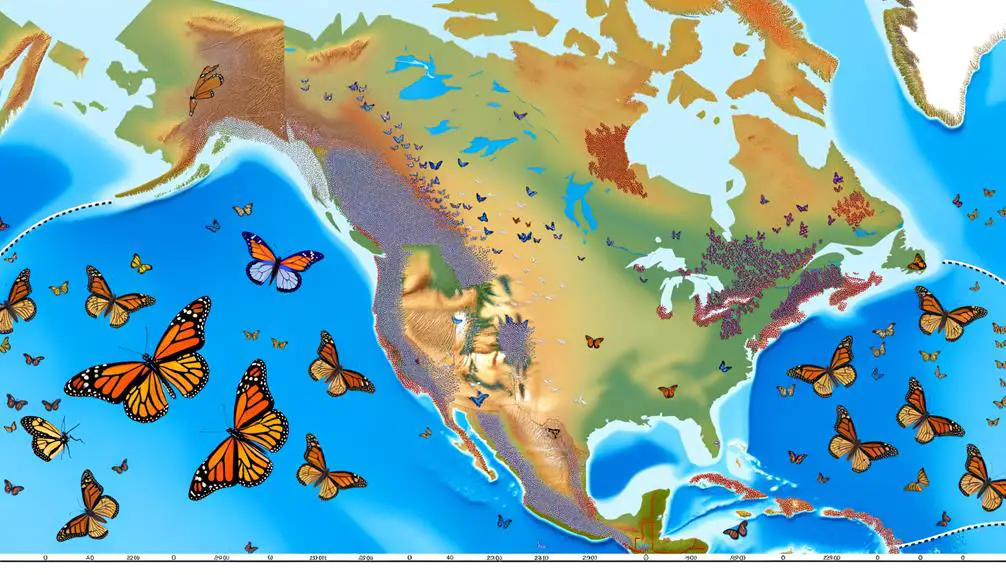
The geographic distribution of the Monarch Butterfly (Danaus plexippus) mainly spans across North America, while the Painted Lady (Vanessa cardui) exhibits a more cosmopolitan range, inhabiting multiple continents.
Monarchs are chiefly found in the United States, Canada, and Mexico, thriving in habitats ranging from meadows to coastal areas. Conversely, the Painted Lady boasts a wide distribution across Europe, Asia, Africa, and Australia, making it one of the most widespread butterfly species.
This species can adapt to diverse environments, including deserts, grasslands, and urban areas. The broader distribution of the Painted Lady underscores its ecological versatility compared to the Monarch.
Both species' geographic ranges underscore their adaptability, yet highlight distinct ecological niches and habitat preferences.
Migration Patterns
Monarch butterflies undertake one of the most remarkable long-distance migrations in the insect world, traveling up to 3,000 miles from North America to their overwintering sites in Mexico. This migration is driven by environmental cues such as changes in temperature and daylight. Monarchs rely on a combination of genetic programming and environmental signals to navigate this extensive journey.
In contrast, Painted Lady butterflies exhibit less predictable migration patterns. Their movements are more opportunistic, often influenced by the availability of food resources and favorable weather conditions. Painted Ladies can travel long distances, sometimes crossing continents, but they do not have a fixed migratory route like Monarchs.
These differences highlight the unique evolutionary adaptations each species has developed for survival.
Life Cycle Stages
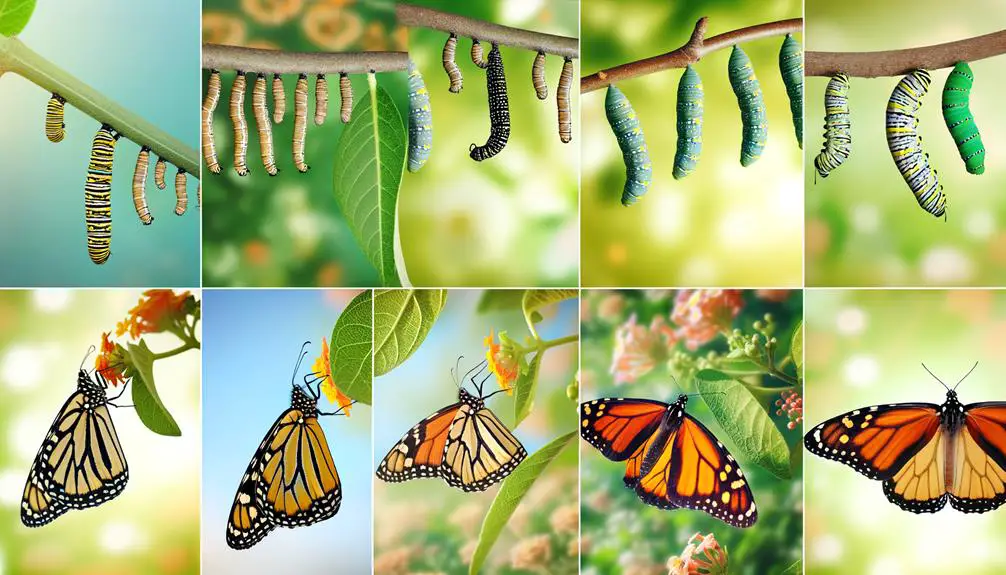
Both Monarch and Painted Lady butterflies undergo a complete metamorphosis, progressing through four distinct life cycle stages: egg, larva (caterpillar), pupa (chrysalis), and adult.
The initial stage involves the deposition of eggs on host plants. Upon hatching, larvae emerge and consume plant material voraciously to fuel their development. This larval stage is marked by rapid growth and multiple molts.
Once the larvae reach a critical size, they enter the pupal stage, forming a chrysalis wherein significant morphological transformations occur. Finally, the adult butterfly emerges, characterized by fully developed wings and reproductive capabilities.
Though similar in their life cycle stages, Monarchs and Painted Ladies display unique physiological and behavioral adaptations that reflect their evolutionary histories and ecological niches.
Preferred Habitats
The Monarch butterfly and Painted Lady exhibit distinct preferences in their natural environments and migration patterns.
Monarchs primarily inhabit milkweed-rich areas and undertake extensive migrations from North America to Mexico.
In contrast, Painted Ladies are more adaptable, thriving in various habitats worldwide and exhibiting less predictable migratory behavior.
Natural Environments
Despite their shared classification within the Lepidoptera order, Danaus plexippus and Vanessa cardui exhibit distinct preferences for their natural habitats, influenced by their differing migratory patterns and ecological requirements.
Monarch butterflies (Danaus plexippus) favor milkweed-rich environments, including meadows, grasslands, and open fields which provide essential food sources for larvae and nectar for adults.
In contrast, Painted Ladies (Vanessa cardui) display remarkable habitat flexibility, thriving in diverse settings such as gardens, deserts, and suburban areas. Their larval host plants include thistles and mallows, enabling them to adapt to a wider range of ecological niches.
These habitat preferences underscore the intricate relationships between these species and their respective ecosystems, highlighting their unique strategies for survival and reproduction.
Migration Patterns
Frequently exhibiting remarkable long-distance travel, Monarch butterflies undertake an annual migration spanning thousands of miles between North America and central Mexico, driven by seasonal changes and the need for overwintering sites. Painted Ladies, in contrast, exhibit a more erratic migration pattern, often influenced by climatic conditions and food availability. These butterflies migrate from North Africa to Europe, covering extensive distances but lacking the predictability of Monarchs. Both species utilize various habitats during migration, including meadows, grasslands, and gardens, but have distinct preferences influenced by their migratory behaviors. Below is a comparative table outlining key aspects of their migration patterns:
| Aspect | Monarch Butterfly | Painted Lady |
|---|---|---|
| Migration Distance | Thousands of miles | Variable, often extensive |
| Primary Migration Route | North America to central Mexico | North Africa to Europe |
| Overwintering Sites | Central Mexico | Mediterranean regions |
| Habitat Preferences | Meadows, forests, grasslands | Meadows, gardens, grasslands |
Feeding Habits
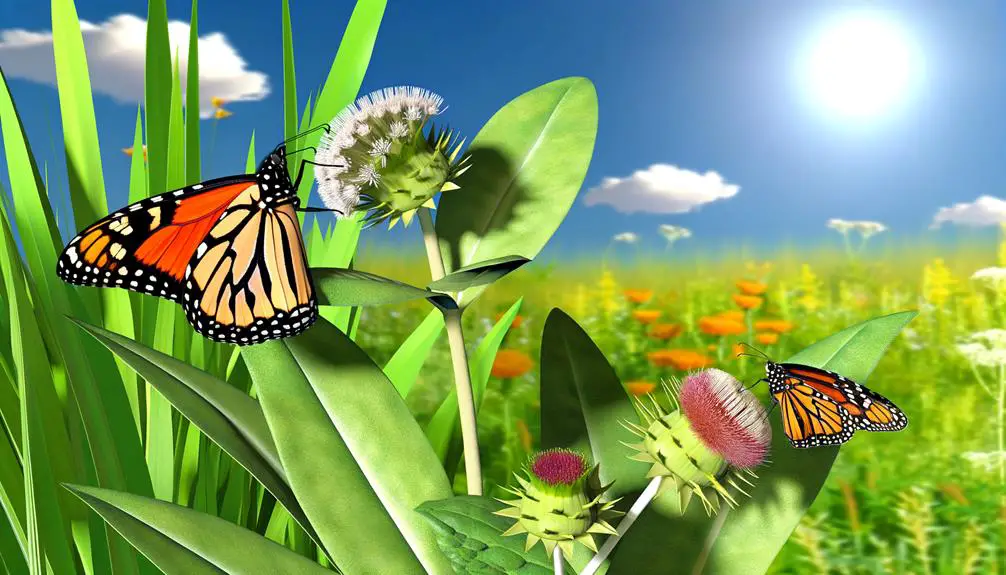
Both monarch butterflies and painted ladies exhibit distinct feeding habits that are intricately linked to their respective life cycles and ecological roles.
Monarch caterpillars exclusively consume milkweed, which imparts toxic compounds that deter predators. Adult monarchs feed on nectar from a diverse array of flowers, thereby contributing to pollination.
Painted lady caterpillars, in contrast, have a broader diet, including thistles and mallows, allowing for greater adaptability to various habitats. Adult painted ladies also rely on nectar but are less specialized, feeding from numerous floral sources. This dietary flexibility underscores their widespread distribution.
Understanding these feeding habits is essential for conservation efforts, as the availability of specific host plants directly impacts their survival and reproductive success.
Predators and Threats
Monarch butterflies and painted ladies face a myriad of predators and threats that greatly impact their populations and ecological roles.
Predation by birds, spiders, and wasps is a significant natural threat. Monarchs possess toxic cardenolides, derived from milkweed, deterring many predators; however, some species have adapted to tolerate these toxins. Painted ladies, lacking such chemical defenses, rely more on camouflage and rapid flight to evade predators.
Anthropogenic factors, including habitat destruction, pesticide use, and climate change, exacerbate these risks. The loss of milkweed plants critically threatens monarchs, while painted ladies are affected by the reduction of their diverse larval host plants.
Both species suffer from parasitic infections, further stressing their populations. Preservation efforts are essential for their survival.
Role in Ecosystems
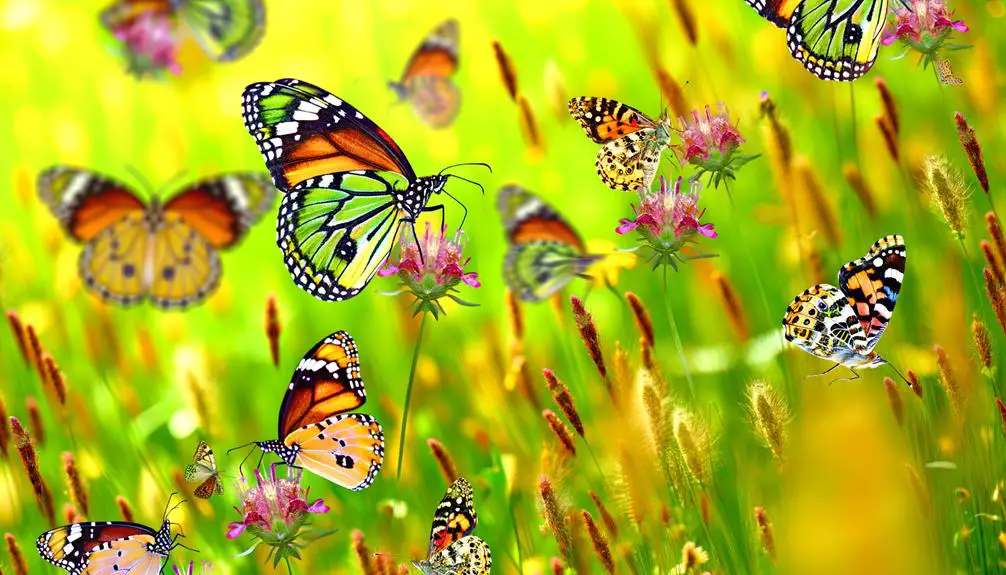
As keystone pollinators, monarch butterflies and painted ladies play essential roles in maintaining the health and diversity of their respective ecosystems.
These insects contribute considerably to the pollination of various plant species, ensuring the continuation of food webs and habitat structures.
Their activities aid in:
- Pollination Efficiency: Monarchs and painted ladies enhance genetic diversity in flora by transferring pollen across large geographic areas.
- Food Source: They serve as critical prey for numerous predators, including birds and small mammals, thereby supporting higher trophic levels.
- Indicator Species: Changes in their populations can signal shifts in environmental health, making them fundamental for ecological monitoring.
Their ecological roles underscore the importance of preserving these species for ecosystem stability and resilience.
Conservation Status
Evaluating the conservation status of monarch butterflies and painted ladies reveals significant concerns regarding population declines and habitat loss.
Monarch butterflies (Danaus plexippus) are particularly vulnerable, with their populations experiencing dramatic declines due to factors such as deforestation, pesticide use, and climate change. The International Union for Conservation of Nature (IUCN) has listed the monarch as endangered, underscoring the urgency for conservation measures.
In contrast, painted ladies (Vanessa cardui) have not yet been classified as threatened, despite facing similar environmental challenges. Their broader geographical range and higher reproductive rates offer them a buffer against rapid population decreases.
Nonetheless, both species require concerted conservation efforts to guarantee their survival and the preservation of their critical roles in ecosystems.
Conclusion
To summarize, the distinctions between the monarch butterfly and the painted lady encompass a variety of aspects, including physical appearance, wing patterns, and migration behaviors.
Significantly, the monarch butterfly's annual migration can span up to 3,000 miles, showcasing a remarkable navigational ability.
Both species face threats from habitat loss and climate change, underscoring the necessity for conservation efforts.
Their roles in ecosystems as pollinators and prey highlight their ecological importance, further justifying the need for protective measures.




